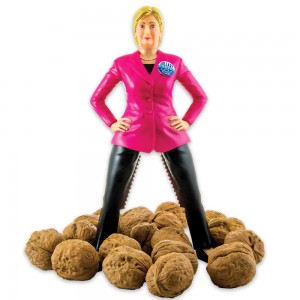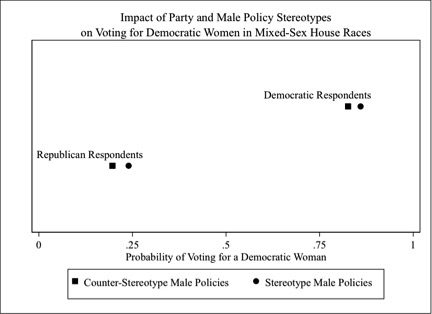Gender Bias Hurts Women Candidates Much Less than Election Year Anecdotes Would Suggest
 In April 2015, the Barbara Lee Family Foundation (BLFF) and the Center for American Women and Politics (CAWP) launched Presidential Gender Watch 2016, a project to track, analyze, and illuminate gender dynamics in the 2016 presidential election. With the help of expert scholars and practitioners, Presidential Gender Watch worked for 21 months to further public understanding of how gender influences candidate strategy, voter engagement and expectations, media coverage, and electoral outcomes in campaigns for the nation’s highest executive office. The blog below was written for Presidential Gender Watch 2016, as part of our collective effort to raise questions, suggest answers, and complicate popular discussions about gender’s role in the presidential race.
In April 2015, the Barbara Lee Family Foundation (BLFF) and the Center for American Women and Politics (CAWP) launched Presidential Gender Watch 2016, a project to track, analyze, and illuminate gender dynamics in the 2016 presidential election. With the help of expert scholars and practitioners, Presidential Gender Watch worked for 21 months to further public understanding of how gender influences candidate strategy, voter engagement and expectations, media coverage, and electoral outcomes in campaigns for the nation’s highest executive office. The blog below was written for Presidential Gender Watch 2016, as part of our collective effort to raise questions, suggest answers, and complicate popular discussions about gender’s role in the presidential race.
It isn’t too difficult to observe elections in the United States and find evidence of women candidates being viewed from a gendered, often negative, perspective. The Hillary Clinton nutcracker. Sarah Palin as Caribou Barbie. The endless attention to the hair, clothing, and physical appearance of women candidates. The examples span the levels of government and the range of offices women seek. Hillary Clinton is ordered to stop “shouting” when she speaks to supporters after an exciting night of five primary victories. Donald Trump asks if voters could support someone with Carly Fiorina’s face. Even a candidate for the Ohio state legislature, Jennifer Herold, is scolded by her opponent that she shouldn’t be running for office as the mother of very young children. Observing the candidacies of women in the United States is to encounter frequent and far-ranging public conversations about whether women’s looks, personalities, experiences, abilities, and family status help or hinder their chances of election.

These examples of women candidates being evaluated through a clearly gendered lens illustrate the role that women’s sex and gender-related issues still play in American politics. Primary here are questions of the importance of gender stereotypes to evaluations of women who run for office. The disciplines of political science and social psychology offer ample evidence that people do hold stereotypes about women and men who run for office. Women candidates are often seen as more compassionate and honest, while men are seen as strong and decisive leaders.[1] Women are assumed to be better able to handle “female” policies like education and health care, while men are thought to be better at the “male” issues, like economic and national security.[2] And women are generally perceived to be more liberal than men, with both Democratic and Republican women seen as to the left (relatively speaking) of men in their parties.[3] Research often warns that gender stereotypes can work against women candidates if voters perceive them as lacking the “right” skills and abilities for office, particularly as the level of office sought rises from local to national and as women compete for executive, as opposed to legislative, offices.[4]
However, this belief that voters approach women candidates with traditional gendered expectations is hard to square with the reality of evolving attitudes toward women in political life. Public opinion demonstrates higher levels of support for the idea of a woman president than ever before, along with support for the belief that government would be better with more women in elected office. Stereotypes appear to be changing too, with recent work suggesting that the public is less likely to hold traditional masculine and feminine stereotypes about women and men.
What explains this disconnect between research that identifies gender stereotypes about women candidates, on one hand, and increased attitudinal and electoral support for women on the other? One explanation examines the limitations of earlier work on gender stereotypes. For one thing, much of the work on the impact of gender stereotypes is experimental, asking subjects to react to “Susan” or “John” White or querying them about whether they support a hypothetical woman for president. While people might respond in gender stereotyped ways when asked to evaluate a hypothetical woman or man candidate, we can’t assume that voters would approach real candidates in the same way.
In an attempt to gather data that would allow me to examine how people evaluate women candidates in real elections, I conducted a two-wave panel survey of 3150 U.S. adults in 29 states in 2010. The sample included respondents who had experienced either same-sex (man v. man) or mixed sex (woman v. man) races for the U.S. House of Representatives. One of the main goals of the survey was to determine whether voters employed their gender stereotypes when evaluating and choosing candidates. To allow for this, I used the two waves of the survey to separately measure respondent gender stereotypes about the policy competence and personality traits of “women and men who run for office” as well as their evaluations of the policy competencies and traits of the specific candidates in their House elections. These data allow me to link the gender stereotypes people may (or may not) hold with their specific actions – candidate evaluations and vote choice – toward specific candidates in their elections.
Examining the candidate evaluations and vote choices people make in races where women run against men for the U.S. House, I find very little evidence that abstract gender stereotypes hurt or help these women. In examining how people evaluate candidates, I find that policy or trait stereotypes people hold about women and men are not related to their evaluations of Republican women candidates. Things are a bit different for Democratic women candidates, however; voters who believe men to be better at traditionally “male” issues were more likely to evaluate the male candidate as stronger on these issues. Beyond this, the most important influence on voter evaluations of all women candidates is political party — specifically, whether a voter shares the party of the woman candidate. In all circumstances, voters who share the party of a woman candidate are overwhelmingly likely to evaluate her as superior to her male opponent.
The same patterns are evident when I examine vote choices. No evidence supports warnings from past research that gender stereotypes will cost women candidates votes. In my analysis, none of the female and male policy or trait stereotypes is significantly related to voting for or against women candidates. Instead, for both Democratic and Republican women candidates, voters rely on traditional political signals like party, incumbency, and campaign spending in making their vote choice decisions. Voters are overwhelmingly likely to support the candidate of their party, regardless of the sex of the candidate.

This difference in the impact of gender stereotypes and political party correspondence on voting for women is evident from the example in figure 1. This figure compares the impact of one stereotype – ideas about men’s superiority on male policy issues – with the impact of political party on a voter’s willingness to vote for a Democratic woman running for the House. Republican voters who hold traditional stereotypes about men’s superiority on male issues have the same low likelihood of voting for a Democratic woman as do Republicans who see woman as capable of handling issues like crime and the economy – about 25 percent. Democrats, on the other hand, are overwhelmingly likely to vote for the Democratic woman – about 85 percent of the time — regardless of whether they see women or men as better at handling male policies. Given what we know about the centrality of party to shaping political decisions, it makes sense that gender stereotypes would not overwhelm traditional influences like political party.
As we gear up for another election season, these data can give us some assurance that, despite high visibility anecdotal examples of sexist attitudes toward women candidates, there is little evidence that women are harmed by their sex.
[1] Huddy, Leonie and Nayda Terkildsen. 1993. “Gender Stereotypes and the Perception of Male and Female Candidates.” American Journal of Political Science 37: 119-47.
[2] Brown, Clyde, Neil Heighberger, and Peter Shocket. 1993. “Gender-Based Differences in Perceptions of Male and Female City Council Candidates.” Women and Politics 13: 1-17.
[3] Koch, Jeff. 2002. “Gender Stereotypes and Citizens’ Impression of House Candidates Ideological Orientations.” American Journal of Political Science 46: 453-62.
[4] Huddy, Leonie and Nayda Terkildsen. 1993. “The Consequences of Gender Stereotypes for Women Candidates at Different Levels and Types of Offices.” Political Research Quarterly 46: 503-25.

